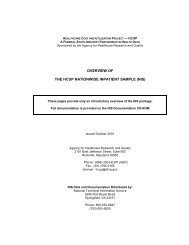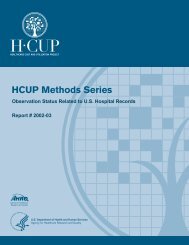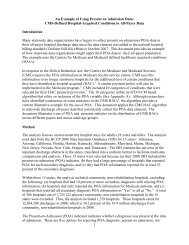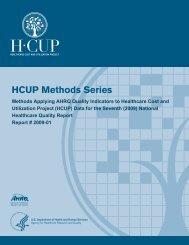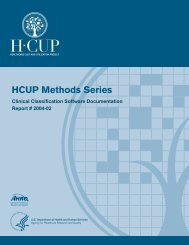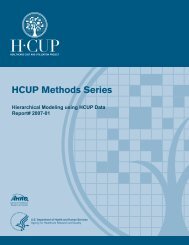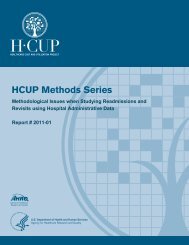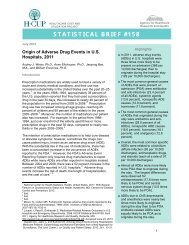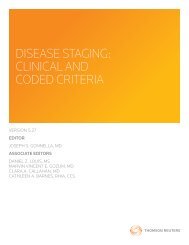Methods Applying AHRQ Quality Indicators to Healthcare ... - HCUP
Methods Applying AHRQ Quality Indicators to Healthcare ... - HCUP
Methods Applying AHRQ Quality Indicators to Healthcare ... - HCUP
You also want an ePaper? Increase the reach of your titles
YUMPU automatically turns print PDFs into web optimized ePapers that Google loves.
Assign Additional Measures for Reporting. We assigned median household incomequartile using the Claritas ZIP Code data linked <strong>to</strong> patient’s ZIP Code in the SID.Beginning with the 2008 NHQR and NHDR, we added reporting by the National Centerfor Health Statistics (NCHS) county-level classification of urban-rural location, whichincludes gradations of metropolitan, micropolitan, and non-core counties by populationsize.3. For the NHDR, the <strong>HCUP</strong> SID were used <strong>to</strong> create disparities analysis files designed <strong>to</strong>provide national- and State-level estimates for the report and derivative products. Of the 42States participating in the 2008 SID, the following 31 <strong>HCUP</strong> States report race/ethnicity ofdischarges: Arizona, Arkansas, California, Colorado, Connecticut, Florida, Georgia, Hawaii,Kansas, Kentucky, Maine, Maryland, Massachusetts, Michigan, Missouri, Nevada, NewHampshire, New Jersey, New York, Oklahoma, Oregon, Pennsylvania, Rhode Island, SouthCarolina, Tennessee, Texas, Utah, Vermont, Virginia, Wisconsin, and Wyoming.The SID were used <strong>to</strong> create a disparities analysis file that was designed <strong>to</strong> provide nationalestimates for the NHDR, using a weighted sample of hospitals from the 31 <strong>HCUP</strong> States.Appendix A <strong>to</strong> this report provides detail on the creation of the disparities analysis file fornational estimates. The individual SID were used <strong>to</strong> create additional disparities analysisfiles for State-level reporting by race/ethnicity. Appendix B <strong>to</strong> this report provides detail onthe creation of disparities analysis files for State-level estimates. For the list of dataorganizations that contribute race and ethnicity data <strong>to</strong> the <strong>HCUP</strong> databases (and that wereincluded in the disparities analysis file), see Table 2 at the end of this methods report.4. The SID were also used for reporting by State and State-level subpopulations(race/ethnicity, community income quartile, and expected primary payer). Given the varieddistribution of race, ethnicity, and socioeconomic groups across states, policymakersincreasingly want <strong>to</strong> know if and how quality of care varies for these different populations.State-level QI estimates are only reported for participating <strong>HCUP</strong> Partners that agree <strong>to</strong>release information.STEPS TAKEN TO APPLY <strong>AHRQ</strong> QUALITY INDICATORS TO THE <strong>HCUP</strong> DATATo apply the <strong>AHRQ</strong> <strong>Quality</strong> <strong>Indica<strong>to</strong>rs</strong> <strong>to</strong> <strong>HCUP</strong> hospital discharge data for the NHQR andNHDR, several steps were taken: (1) QI software review and modification, (2) acquisition ofpopulation-based data, (3) assignment of QIs <strong>to</strong> the <strong>HCUP</strong> databases, and (4) identification ofstatistical methods.1. Review and Modify QI Software. For the 2011 NHQR and NHDR, we used a “modifiedversion” of the 4.1 software. We started with version 4.1a, included software correctionsfrom version 4.1b, then added software corrections (but not definitional changes) fromversion 4.2. In addition, we did not utilize the present on admission (POA) estimationmodule for the IQIs, PDIs, and PSIs since POA indica<strong>to</strong>rs were not uniformly available fromStates that contribute <strong>to</strong> the <strong>HCUP</strong> databases. Specific modifications are noted as footnotein the tables. Because each of these software modules was developed for State andhospital-level rates, rather than national rates, some changes <strong>to</strong> the QI calculations werenecessary.We added four indica<strong>to</strong>rs particularly relevant <strong>to</strong> the structure of the NHQR and NHDR. Twoindica<strong>to</strong>rs were created for discharges age 65 years and older: immunization-preventableinfluenza, age 65 and over; and asthma admissions, age 65 and over. Two additional<strong>Methods</strong> for <strong>HCUP</strong> Data in 2011 NHQR and NHDR 3December 9, 2011



